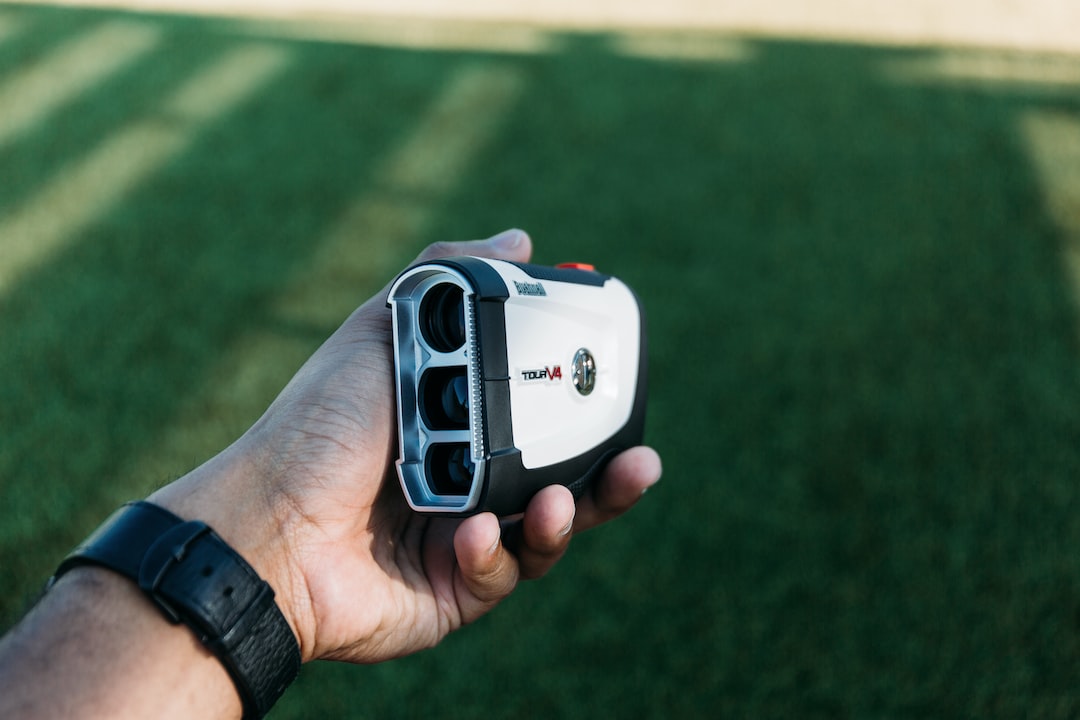Are you looking for the best rangefinder for hunting?
Deciding on the optimal rangefinder for your hunting needs can be a complex task, as there are numerous options in terms of brands and types.
It’s important to consider features like angle compensation, line of sight accuracy, cost considerations and more when choosing your rangefinder.
To ensure you make a knowledgeable decision about the ideal rangefinder for your hunting purposes, we will provide an in-depth analysis of all relevant factors such as angle compensation, line of sight accuracy, cost considerations and more.
Rangefinder Basics
Rangefinders are a type of optical device used to measure distances. They use lasers or GPS signals to calculate the distance between two points. Rangefinders are commonly used by hunters and outdoorsmen for measuring distances in order to make more accurate shots when hunting.
What is a Rangefinder?
A rangefinder is an optical instrument that uses either laser technology or GPS signals to accurately measure the distance between two points. Rangefinders, which can be handheld, affixed to rifles or connected to binoculars, are advantageous for taking accurate long-range shots at wildlife like deer, elk and moose.
How Does it Work?
Laser rangefinders work by emitting pulses of light which reflect off an object and back into the device’s optics where they are measured in terms of time taken for them to return. The amount of time it takes for the pulse of light to return is proportional to the distance between you and that object.
GPS rangefinders work similarly but instead rely on satellites orbiting Earth in order to determine your location relative to other objects around you so that it can then calculate their exact distance away from you with pinpoint accuracy regardless of terrain features like hills and valleys.
Rangefinders are an invaluable tool for any hunter, providing accuracy and convenience in the field. Comprehending the distinctions between all the varieties of rangefinders on offer is essential when making a choice to buy.
Types of Rangefinders
Laser rangefinders are the most popular type of rangefinder for hunting.
They use an invisible laser beam to measure distances to 1000+ yards away with accuracy within a few inches. These devices can be used in all types of terrain and weather conditions and offer features such as angle compensation technology which allows hunters to accurately account for uphill or downhill shots when calculating distance. Laser rangefinders, offering convenience and affordability, are lightweight and simple to operate.
GPS rangefinders combine GPS satellite navigation with laser ranging capabilities. This allows them to provide detailed maps that show exact locations as well as accurate distance measurements even in areas without cell phone coverage or line-of-sight visibility between the user and target object.
Nevertheless, due to their sophisticated technology and mapping features, they usually cost more than laser rangefinders.
Thermal imaging rangefinders are designed specifically for night hunting applications by using infrared light emitted from warm objects like animals or people instead of visible light reflected off targets like trees or rocks, as traditional laser rangefinders do.
Thermal imaging is able to detect heat signatures at greater distances than lasers, making it ideal for long-range shooting scenarios; however, it also tends to be significantly more expensive than other types of ranges finder due its specialized nature and advanced technology requirements.
Rangefinders exist in a variety of forms, each with its own unique traits and advantages for hunting. Popular brands of rangefinders are available to help hunters make the best decision when selecting the right one for their needs.
Popular Brands of Rangefinders for Hunting
Bushnell is a well-known brand in the rangefinder market and offers some of the most advanced models available. Its products are designed for hunters who need reliable performance and accuracy.
The Bushnell Elite 1 Mile ARC 7x26mm laser rangefinder features Angle Range Compensation (ARC) technology, which provides accurate readings even on angled shots up to an impressive 99 yards. It also has a bright OLED display that allows you to quickly read distances in low light conditions, making it ideal for hunting trips at dawn or dusk.
Nikon’s line of rangefinders includes both laser and GPS models with advanced features such as Tru-Target Technology, Hyper Read technology, and 8x magnification lenses.
The Nikon Prostaff 1000 Laser Rangefinder is one of their top-of-the-line offerings, boasting a maximum distance measurement of up to 1,000 yards with +/-1 yard accuracy. This model also comes with multilayer coating on its optics for superior light transmission and clarity when targeting distant objects or game animals.
Vortex Optics also offers rangefinders, and they offer the best cusomer service and warranty in the business.
Popular brands of rangefinders for hunting are typically more reliable and offer a variety of features that can help make your hunt more successful. Now, let’s evaluate certain characteristics when selecting the most suitable rangefinder for you.
Features to Consider When Choosing a Rangefinder for Hunting
When choosing a rangefinder for hunting, there are several features to consider.
Magnification and objective lens size can be critical factors in determining the accuracy of your rangefinder. A larger magnification number indicates that you’ll be able to see further away with more clarity, while an increased objective lens size allows more light into the device, providing better visibility even at greater distances.
If you’re looking for a rangefinder with superior performance and accuracy, it is important to take these two specifications into account when making your selection.
Angle compensation technology is another feature that should be taken into consideration when shopping for a rangefinder specifically designed for hunting purposes. This technology calculates the difference between line-of-sight distance and true horizontal distance to provide an accurate reading regardless of shooting angle or weather conditions.
This ensures that hunters have an accurate reading no matter what angle they may find themselves shooting from in various terrain conditions or weather conditions such as fog or rain.
When selecting a rangefinder for hunting, it is important to consider features such as magnification and objective lens size, angle compensation technology, and line of sight versus true horizontal distance measurement. Now let’s take a look at cost considerations when buying a rangefinder for hunting.
Cost Considerations When Buying a Rangefinder for Hunting
When it comes to buying a rangefinder for hunting, cost is an important factor. The good news is that a rangefinder for hunting can be found at varying price points, both economical and pricey.
It’s important to understand what factors affect price point so you can make an informed decision when choosing a rangefinder for your needs.
For those looking for top-notch performance with advanced features such as angle compensation technology or true horizontal distance measurement capabilities, one may need to shell out a few extra bucks for higher end models from brands like Bushnell or Leupold.
If one is searching for an economical laser rangefinder with 6x magnification and a maximum distance of 400+ yards, there are many accessible models available.
The choice of either the “Cadillac” or just the basic “Chevy” model is ultimately determined by a hunter’s personal preferences and financial capabilities.
FAQs in Relation to Best Rangefinder for Hunting
What is the best rangefinder for hunting on the market?
The best rangefinder for hunting on the market is the Bushnell Elite 1 Mile CONX. This laser rangefinder offers superior accuracy, ranging up to one mile with a +/-1 yard precision and uses Bluetooth connectivity to sync with your smartphone or tablet.
The device offers 7x magnification and an OLED display to make viewing in dark environments a breeze. The unit also has a built-in inclinometer that measures angles from -90° to +90° for precise shot selection at any angle, making it ideal for hunters of all levels who need reliable readings quickly and accurately.
Who makes the most accurate rangefinder?
This device utilizes advanced laser technology to accurately measure distances up to one mile with a +/- 0.5-yard accuracy rating and 6x magnification power.
This device boasts Bluetooth connectivity, allowing users to connect their smartphones for additional data access, as well as a waterproof construction and ergonomic design that make it suitable for use in any environment. The Bushnell Elite 1 Mile CONX Rangefinder offers hunters and sportsmen unmatched precision when tracking game or scouting new terrain.
What should I look for in a hunting rangefinder?
When choosing a hunting rangefinder, it is important to consider several factors.
First, the magnification and objective lens size should be appropriate for your needs; higher magnifications offer more accuracy but may reduce image quality.
Second, look for features such as angle compensation or ballistic calculator functions that can improve accuracy in long-range shooting scenarios.
Third, pay attention to battery life and weight – you don’t want something too heavy or with limited run time when out in the field.
Finally, check customer reviews to ensure that the product meets its advertised specifications and performs reliably in all weather conditions. With these considerations in mind, you will find a reliable rangefinder suitable for your next hunt.
Is a range finder worth it for hunting?
Yes, a range finder is worth it for hunting. You need to know the distance of an animal before taking a shot. Without knowing the range, you could potentially injure an animal which is the last thing any ethical hunter wants to do.
Rangefinders allow hunters to accurately measure distances between themselves and their targets with precision and accuracy.
They can be used to determine the best shooting position or ideal stalking distance, as well as helping hunters identify potential obstacles in their line of sight that may affect shot placement. With the right model, they can even provide information on wind speed and direction which can be invaluable when making long-range shots.
Rangefinders are a must-have for any hunter when out hunting.
Conclusion
Finding the best rangefinder for hunting can be a daunting task.
Doing your due diligence is essential when selecting the rangefinder that best suits your hunting needs from the myriad of options available. Consider what type of hunter you are and how often you’ll use your rangefinder when deciding which model is right for you.
Before buying, ensure that the rangefinder you select has all of the characteristics required for a fulfilling and successful hunt – then get out there and have some fun.



